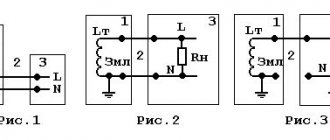How to connect zero and ground in an electrical panel and in what cases is this necessary?
Types of protection against electric shock
In accordance with paragraph 1.1 of GOST 12.1.030-81, protective grounding or grounding (zero-ground connection) is designed to protect people from electric shock in the event of insulation damage when they touch metal non-current-carrying parts of electrical equipment.
Grounding is an intentional or accidental electrical connection of metal parts of electrical equipment, electrical installations, or a network point to a grounding device, busbar or other protective equipment (clause 01-10-09 GOST R 57190-2016).
This could be reinforcement in the ground, building structures or special electrodes. This measure is a mandatory deliberate protection of both residential and non-residential assets.
Grounding is the deliberate connection of metal parts that are not energized in the normal state with a neutral protective conductor (solidly grounded neutral of a transformer or generator).
In accordance with paragraphs 1.1.2, 1.1.3, 1.7 of GOST 12.1.030-81, grounding must be done by electrically connecting metal parts of electrical equipment to a grounded point of the power supply using a neutral protective conductor (PE).
For neutral protective and grounding conductors, you can use: special conductors, as well as metal structures of buildings and structures.
Protective grounding and grounding of electrical equipment must be carried out without fail when using an alternating current voltage with a nominal value of 220 (1 phase) and 380V (3 phases) and higher and a direct current voltage of 440V and higher. In addition, according to clause 1.7.13 of the PUE, the power supply for electrical receivers must be supplied from a 380/220 V network with a TN-S or TN-CS grounding system.
Grounding systems
In accordance with paragraph 1.7.3 of PUE 7, when using electrical equipment designed for voltages up to 1 kV, the following grounding methods are used:
- TN - the zero of the power source (from a substation or generator) is tightly connected to the ground;
- TN-C - TN, where the protective (PE) and working (N) neutral wires are combined in one PEN conductor;
- TN-S - TN, where PE and N neutral wires are separated along the entire line from the substation;
- TN-CS - TN, where PE and N are separated in a certain section of the circuit, and from the substation to this section they are combined;
- CT – the zero from the substation is solidly grounded, and unprotected electrically conductive structures of electrical equipment are connected to a grounding device that is not connected to the solidly grounded zero from the substation;
- IT - the neutral is isolated from the ground or connected to the ground through a high resistance, and the unprotected metal structures of electrical equipment are connected to the ground.
The nuances of installing a protective device
Connecting an RCD in an apartment or house requires compliance with several rules:
- For several groups of consumers it is necessary to install one RCD and individual circuit breakers.
- If there are several RCDs, each of them will need a zero output bus.
- The TN-C system does not need to be zeroed.
- For “wet groups” it is mandatory to install a protective device with a shutdown rating of 10 mA.
- 30 mA devices are suitable for household appliance outlets that operate with water.
- The zero terminal is located on the right side of the device and is marked with the letter N. It should not be confused with the phase (index L).
- Input can be made to the lower or upper terminals.
- The classic circuit is implemented using a top input and a bottom output.
- Each RCD requires a personal zero block to which all working neutrals are connected.
- For lines with ripple currents, type A devices are required.
You can check the health of the system by pressing the “Test” button.
A protective shutdown device is needed to protect against overloads and short circuits. Due to the lack of response to overcurrents, it is installed in combination with a difavtomat. Connection diagrams allow installation of devices in any order. The only condition is the choice of the appropriate denomination.
Is it necessary to install the machine on the neutral wire?
When I worked in public utilities, I saw separate machines at zero and phase. Residents explained that there used to be traffic jams there, then they installed machine guns there.
Most likely this was the case for me. I want to change the input machine. Which one to install single-pole per phase or two. The neighbor has two. And many people put two, but what’s the point?
There may be norms. doc. What kind of thing do you need to install bipolar?
The point is to disconnect from the phase and the working zero, the potential of which is very far from zero.
In this case, you can install a single-pole one before the meter to break only the phase.
want problems? no problem! the project is drawn up according to technical conditions. the project does not correspond to the actual work? = does not correspond to the technical conditions = go to .opu-redo/daybablana!
buy a shield you like and cut the window, cover it with glass. The key question is, of the 3 options, which will be cheaper?
Is it necessary to install the machine on the neutral wire?
In addition to the basic FORUM RULES:
1. Do not forget to indicate the full name, model, brand, manufacturer and brief characteristics of the equipment. 2. Give reasons for your opinion - provide a detailed statement or source of information. 3. It is prohibited to discuss, post requests and links to circuits and equipment that conflict with the law or pose a clear potential threat to use. 4. It is not allowed to give advice like “Throw away this old stuff” and the like. 5. Blatant advertising and self-promotion are subject to shooting accompanied by appropriate punishment 6. It is prohibited to create topics with a request to do some work for the author of the topic. The forum is a means of communication and general search for solutions. No one will do your work for you. 7. It is prohibited to create topics that are not directly related to “Electronics and circuit design.” 8. In this section, swearing in all its forms is STRICTLY prohibited, as well as: Swearing, insults, getting personal.
If you see a violation of the rules of a section or forum, do not be lazy to report it to the moderator. Forum participants who violate the rules will be punished, and those who contribute to the development of the forum will be rewarded (DigiMoney and other joys).
Enjoy your communication!
- Subscribe to topic
- Tell a friend
- Download/print theme
IMHO, the most common reason, I have seen it at least five times. 380 in an outlet is no joke.
If the homemade grounding is also after the meter, then you can periodically turn off the machine, the one that is grounded, and thereby slow down the rotation of the meter by half. Perhaps this innovation contradicts the requirements of energy companies?
In general, of course, there are two machines at the input for insurance. Electricians can change the phasing for some reason at a substation if electricity is supplied through poles to houses. And for apartment panels, it is strongly recommended to use two-pole circuit breakers in front of the meter for each apartment.
because there is no mandatory regulation in which of the holes in the socket there should be a phase and where there should be a zero, accordingly, a two-wire connection to the house is also made - to the drum where to hang the phase and where the zero. By unscrewing both plugs, there is a 100% guarantee that the phase has been removed.
Enough. theoretically, but the electrician sitting on the pole does not know which wire to give the phase to the house, and which zero, if there are two plugs, he doesn’t need to know this. Plus, the lack of obligatory connection of the house (apartment) to the real ground leads to the fact that if you take a “clean” zero and a battery (in no case check my words, or check with a tester), then it may not even be bad to “shake” (in best case).
By the way, in apartment wiring of the modern type (10 years ago it certainly was) this is no longer done; 3 phases and zero stretch along the entrance, wiring in apartments with a uniform load is spread over all three phases. Zero input into the apartments is directly from the zero bus on the entrance panel, and the phase is through an automatic machine (short-circuit and overload protection). but if a radish neighbor cuts off the 220-volt welding, creating an insane load on the contact connections (which are not perfect), then the entrance zero will “burn out” - i.e. will be disconnected from the real zero of the electrical network and the current through the loads of neighboring apartments connected to another phase will flow to the neighboring phase, as a result of which the sockets will not have 220, but 380 volts with all the ensuing consequences. At one time, having thus lost a TV set and a refrigerator, I, like the Snake, had to modify the “safe electrical network” by remaking the connection according to the “bourgeois” version. (By the way, it saved me two more times
)











